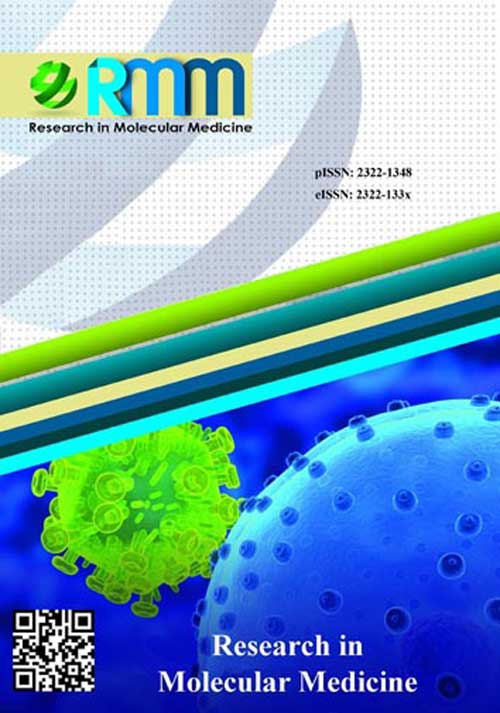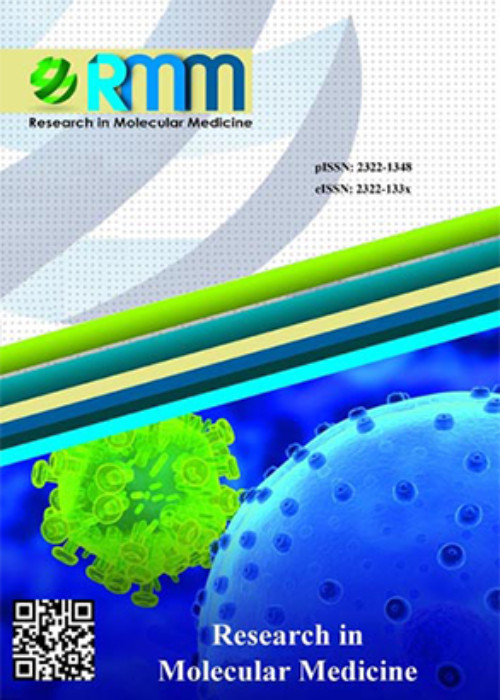فهرست مطالب

Research in Molecular Medicine
Volume:7 Issue: 1, Feb 2019
- تاریخ انتشار: 1397/11/12
- تعداد عناوین: 6
-
-
Pages 1-7Background/ Objective
Gliomas are the most common of the primary brain tumors and accounted for more than 40% of all central nervous system (CNS) tumors. Glioblastoma (GBM) remains one of the most fatal human malignancies because of its high angiogenic. Foretinib is an oral multikinase inhibitor that represented antitumor activity in clinical studies. AURKA and AURKB genes have been shown to be overexpressed in various cancers. Thus, the purpose of this study was to investigate the impact of foretinib on expression changes of AURKA and AURKB genes in T98 cell line.
Materials and MethodsIn this experimental study, the T98 cell line was selected as an experimental model of glioblastoma. Cell cultured were exposed to different concentrations of foretinib (5µM, 10µM, 20µM, and 0µM as control). Then, expression changes of AURKA and AURKB genes under the influence of foretinib compared to control were examined using quantitative real-time polymerase chain reaction (qRT-PCR).
ResultsThe expression of AURKA and AURKB genes were found to be significantly reduced in the treated group with foretinib in comparison with control. Results demonstrated a reduction in the expression of both genes studied by increasing the concentration of foretinib.
ConclusionThese findings indicate that the foretinib leads to a decrease in the mRNA levels of AURKA and AURKB. Thus, our results suggested that foretinib may be an effective drug for GBM which should be considered for future studies.
Keywords: AURKA, AURKB, Foretinib, Glioblastoma -
Pages 8-15Background
Some plant extracts can prevent kidney stone formation in a dosedependent manner. In our study, we aimed to investigate the protective role of Cannabis sativa aqueous extraction on calcium oxalate formation in ethylene glycolinduced rats.
Materials and MethodsTo evaluate anti-urolithiasis, variations of the main risk factors (citrate, phosphorous, calcium, and Ph) have been evaluated in 24-hour urine samples of rats one day before the end of the experiment. Rats were divided into 4 groups: group 1 was administered regular drinking water; group 2 was administered 1% ethylene glycol in drinking water, group 3 was administered 100 mg/kg of Cannabis sativa extract for oral administration by gavage along with drinking water containing 1% ethylene glycol; and group 4 was administered 200 mg/kg of Cannabis sativa extract by gavage along with drinking water containing 1% ethylene glycol. Finally, histopathological slides from the kidney were also evaluated.
ResultsResults showed that 100 mg/kg and 200 mg/kg doses of Cannabis sativa extract significantly reduced the mentioned risk factors in comparison with ethylene glycol-treated rats (p<0.05).
ConclusionHistopathological slides showed reduced calcifications with extract treatment at 200 mg/kg of Cannabis sativa. Thus, this antioxidant herb can prevent kidney stone formation. These findings pave the way for new therapy.
Keywords: Cannabis sativa, Ethylene Glycol, Rats, calcium oxalate stone -
Pages 16-25Backgrounds and objectives
Interleukin 2 (IL-2) secreted by activated CD4+ T cells has been known as a major mediator in both adaptive and native immune system due to a board range of effects on different cells in the immunity system (1-6).
MethodscDNA synthesis was performed using gene- specific primers designed by Gene Runner software after RNA extraction of mouse splenocytes. PCR product purification carried out after IL-2 coding sequence amplification and was ligated into the pET-21b (+) vector and transformed into competent TOP10 E.Coli. Expression and purification of recombinant mouse IL-2 were done using IPTG inducer and metal affinity chromatography respectively.
ResultsDNA sequencing confirmed the accuracy of the insertion process. 23 KDa exogenous protein was observed on the SDS-PAGE. Specificity and concentration of produced mouse recombinant IL-2 protein were confirmed by western blotting and BCA methods.
ConclusionRecombinant IL-2 has produced in BL21 (DE3) pET-21b (+) expression system at 24°C in the soluble form.
Keywords: Recombinant protein, pET-21b (+), IL-2 protein, Cloning -
Pages 26-34Background
Liver cancer is the second outstanding reason for cancer-related death global and thus a main public health challenge. Plant-based drugs are regarded as promising therapies. Basil and Dracocephalum kotschyi extracts have shown therapeutic impacts on various cancers. Therefore, we assessed the effects of the extract of Basil and Dracocephalum kotschyi on cell proliferation and BCL2 expression in the HepG2 cell line.
Materials and MethodsIn this experimental study, the HepG2 cell line was selected for treatment with the alcoholic extract of Basil and Dracocephalum kotschyi extracts. Cell proliferation was examined in the presence of various concentrations of the Basil and Dracocephalum kotschyi extracts by MTT-assay. Moreover, the effect of the alcoholic extract of Basil and Dracocephalum kotschyi on BCL2 expression was evaluated using quantitative real-time polymerase chain reaction (qRT-PCR).
ResultsCell proliferation studies represented anticancer characteristics of dose-dependent of the alcoholic extract of Basil and Dracocephalum kotschyi. Additionally, the extract of Basil and Dracocephalum kotschyi led to the decreased expression of BCL2 in HepG2 cell line.
ConclusionThese findings propose Basil and Dracocephalum kotschyi as two promising candidates for future anticancer research.
Keywords: Basil, BCL2, Dracocephalum kotschyi, HepG2, Liver cancer -
Pages 35-41Background
The isolation of the TEM gene in Pseudomonas aeruginosa and Escherichia coli and the antibiotic resistance pattern provides useful information on the epidemiology and factors involved in these infections.
AimThe aim of this study was to evaluate antibiotic resistance and abundance of a beta-lactamase gene (TEM) in P.aeruginosa and E.coli isolated from clinical specimens by the polymerase chain reaction.
Materials and methodsIn this study, 120 samples of P.aeruginosa and 86 samples of E.coli isolated from urine and sputum were identified using biochemical methods. Antimicrobial resistance pattern was investigated by disc diffusion method (Kirby-bayer). Then ESBL phenotypic study was performed using a combined disk method. Finally, the TEM gene was examined in the strains by polymerase chain reaction.
ResultsIn this study, the highest resistance to P.aeruginosa samples was detected with tetracycline and amoxicillin antibiotics with 97.5% and 95% frequency. The highest sensitivity to the aztreonam and amikacin antibiotics was 73.33% and 61.66%, respectively. Also, 56.66% of samples had TEM gene. In E.coli samples, the highest resistance to antibiotics such as Co-trimoxazole and Amoxicillin was 59.34% and 55.04% and observed the highest sensitivity to Imipenem antibiotics was 69.66% and Chloramphenicol with 61.92% and 72.09% of the samples had TEM gene.
ConclusionsThese findings indicate an increase in bacterial resistance to antibiotics. So, the need to decide on the rational use of drugs and the importance of using new diagnostic methods and molecular methods to identify ESBL producing strains in microbiological laboratories.
Keywords: Antimicrobial, Escherichia coli, Pseudomonas aeruginosa, TEM -
Pages 42-50Background
One of the drinks that are increasingly popular among athletes is beetroot juice. This survey was undertaken to determine the effects of acute beetroot juice consumption on certain hematological parameters, lipid profiles, and total antioxidant capacity in female soccer players.
Materials and MethodsThis was an applied, semi-experimental study. Female soccer players (n = 30, age = 23.16 ± 0.79 years) were selected randomly and assigned into three groups: experimental (beetroot juice, n = 10), (control (placebo), n = 10) and (mouth rinsing, n = 10). Subjects undertook soccer training for a session (90 min) with consumption of 200 ml juice 2 h before they started. Blood samples were collected and investigated before and after training. Paired sample t-tests were used for comparison within groups, and one-way ANOVA was used for comparison between groups. All statistical analyses were performed at P ≤ 0.05.
ResultsAfter a session of using beetroot juice, there were no significant differences in blood indices (levels of hemoglobin, hematocrit, red blood cells, iron, and mean corpuscular volume), lipid profiles (triglycerides, total cholesterol, and high density lipoprotein), and total antioxidant capacity between groups (experimental, control, and mouth rinsing) (P > 0.05), but low density lipoprotein concentrations changed significantly (P < 0.0001).
ConclusionsDrinking a dose of beetroot juice did not improve hematological parameters, lipid profiles, and total antioxidant capacity. Therefore, our study of daily consumption of this drink will be pointed out to subsequent researchers.
Keywords: Beetroot juice, Female Soccer players, Training


